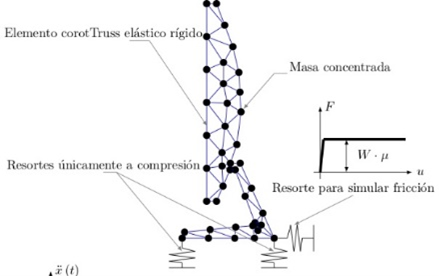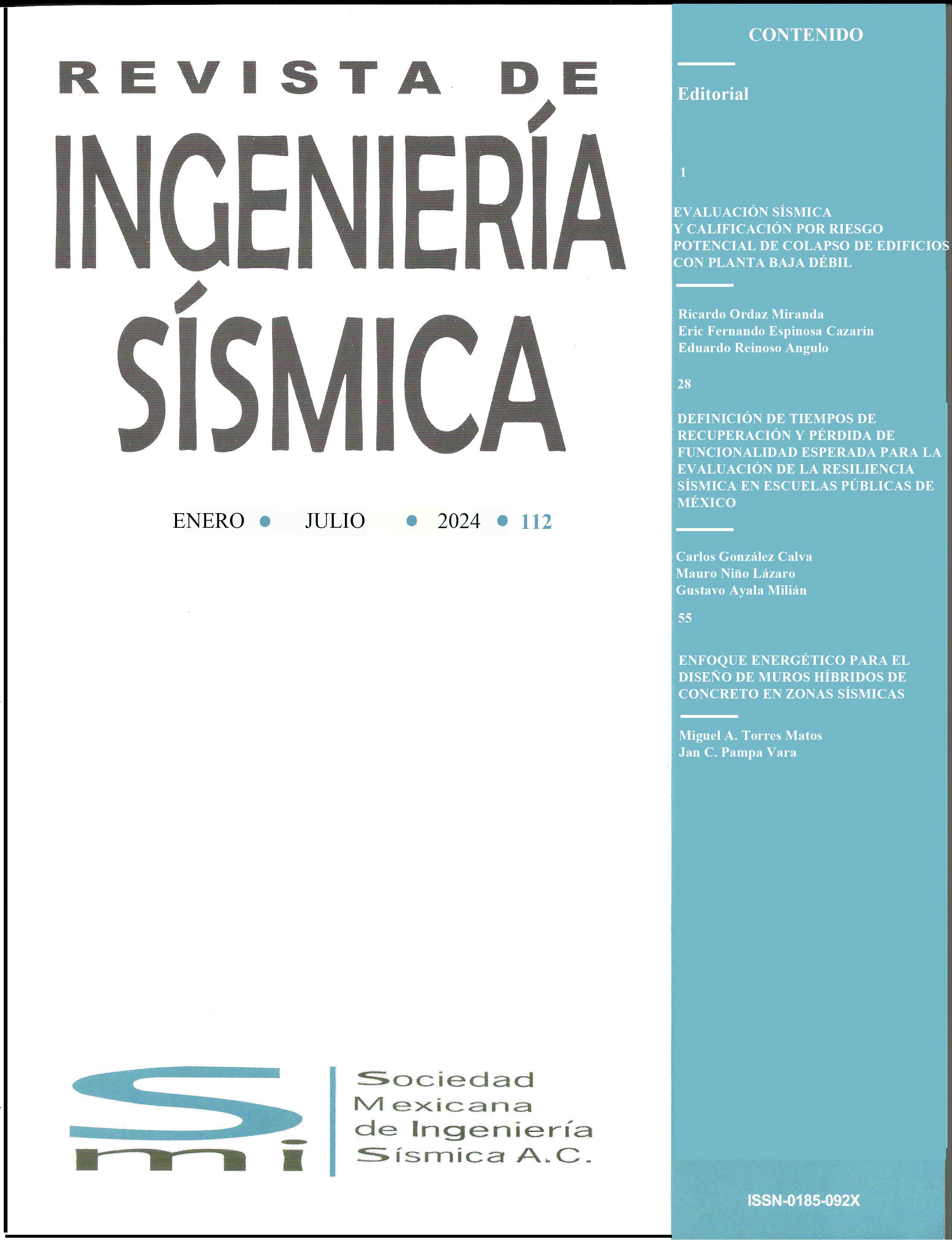DISTORSIÓN DE ENTREPISO ÓPTIMA PERMISIBLE PARA EL DISEÑO DE EDIFICIOS IMPORTANTES, CONSIDERANDO DAÑO EN SUS CONTENIDOS
DOI:
https://doi.org/10.18867/ris.114.683Palabras clave:
distorsión máxima permisible de entrepiso, distorsión de diseño óptima, daño en contenidos, edificios escolares, costo total esperado, ciclo de vidaResumen
Se presenta una metodología para determinar la distorsión máxima de entrepiso (dOI) óptima que garantice el cumplimiento del nivel de desempeño de Ocupación Inmediata (OI), requisito para las estructuras importantes (Grupo A) de acuerdo con la Norma Técnica Complementaria para Diseño por Sismo (NTC-DS-2023). La metodología se desarrolla en dos etapas: en la primera, se determina la tasa de excedencia de la respuesta estructural mediante la integración de curvas de fragilidad estructural con la tasa de excedencia de intensidades sísmicas del sitio. En la segunda, se evalúa el costo total esperado durante el ciclo de vida del edificio, mediante simulación numérica, con énfasis en las pérdidas económicas por daños en contenidos sensibles a aceleración de piso. Para realizar esta evaluación, se propone una función de costos por daño en contenidos que considera la aceleración máxima de piso y su variación a lo largo de la altura del edificio, formulándose primeramente a nivel de inventario, y posteriormente, a nivel global. La metodología se aplica a un edificio escolar de cinco niveles con marcos resistentes a momento, de concreto reforzado, ubicado en la zona de transición de la Ciudad de México. Para el diseño de la estructura se suponen cuatro valores permisibles de dOI= 0.005, 0.0075, 0.01 y 0.0125. Se obtiene que la distorsión máxima de entrepiso correspondiente al mínimo costo total esperado es igual a 0.01, valor que es mayor al límite especificado por la NTC-DS-2023, el cual es igual a 0.0075 para marcos de concreto reforzado.
Descargas
Citas
Alamilla, J. L., Rodríguez, J. A., y Vai, R. (2020). Unification of different approaches to probabilistic seismic hazard analysis. Bulletin of the Seismological Society of America, 110(6), 2816-2827. https://doi.org/10.1785/0120200148
Alamilla, J., y Tolentino, D. (2018). Optimun design and damage control for load sequences. Structural Safety, 72, 54-64. https://doi.org/10.1016/j.strusafe.2017.12.006
American Society of Civil Engineers. (2021). Minimum design loads and associated criteria for buildings and other structures.
Anelli, A., Santa-Cruz, S., Vona, M., Tarque, N., y Laterza, M. (2018). A proactive and resilient seismic risk mitigation strategy for existing school buildings. Structure and Infrastructure Engineering, 15(2), 137-151. https://doi.org/10.1080/15732479.2018.1527373
Baker, J. W., y Cornell, C. A. (2005). A vector-valued ground motion intensity measure consisting of spectral acceleration and epsilon. Earthquake Engineering & Structural Dynamics, 34(10), 1193-1217. https://doi.org/10.1002/eqe.474
Bojórquez, E., Iervolino, I., Reyes-Salazar, A., y Ruiz, S. (2012). Comparing vector-valued intensity measures for fragility analysis of steel frames in the case of narrow-band ground motions. Engineering Structures, 45, 472-480. https://doi.org/10.1016/j.engstruct.2012.07.002
Bojórquez, E., Leyva, H., Reyes-Salazar, A., Fernández, E., Bojórquez, J., Leal, J., y Serrano, J. (2018). Diseño óptimo multiobjetivo de edificios de concreto reforzado usando algoritmos genéticos. Revista Ingeniería Sísmica(99). https://doi.org/10.18867/ris.99.484
Bojórquez, J., Ruiz, S. E., Ellingwood, B., Reyes-Salazar, A., y Bojórquez, E. (2017). Reliability-based optimal load factors for seismic design of buildings. Engineering Structures, 151(15), 527-539.
Chen, H., Xie, Q., Lan, R., Li, Z., Xu, C., y Yu, S. (2015). Seismic damage to schools subjected to Nepal earthquakes. Natural Hazards, 88(1), 247-284. https://doi.org/10.1007/s11069-017-2865-8
De León, D. (1996). Integrating socio-economics in the development of criteria for the aseismic design of reinforced concrete structures. Ph. D. Thesis, University of California, Departament of Civil and Envionmental Engineering, Irvine California.
De León, D., y Donaji, A. (2020). Towards a resilient design and retrofit of schools in Mexico. The 17th Wolrd Conference on Earthquake Engineering. Sendai, Japón.
De León, D., y Garcia-Manjarrez, J. (2021). Cost and reliability of retrofit alternatives for schools located on seismic zones. Earthquakes and Structures, 21(5), 505-514. https://doi.org/10.12989/eas.2021.21.5.505
De León, D., Ang, A., y Guadarrama, D. (2023). Reliability-based selection of retrofit works for schools under seismic hazard. Natural Hazards Review, 24(3). https://doi.org/10.1061/NHREFO.NHENG-1408
Di Ludovico, M., Digrisolo, A., Moroni, C., Graziotti, F., Manfredi, V., Prota, A., . . . Manfredi, G. (2019). Remarks on damage and response of school buildings after the Central Italy earthquake sequence. Bulletin of Earthquake Engineering, 17(10), 5679-5700. https://doi.org/10.1007/s10518-018-0332-x
Di Ludovico, M., Santoro, A., De Martino, G., Moroni, C., Prota, A., Dolce, M., y Manfredi, G. (2019). Cumulative damage to school buildings following the 2016 central Italy earthquake sequence. Bolletino di Geofisica Teorica ed Applicata, 60(2), 165-182.
Dong, G., Hajirasouliha, I., Pilakoutas, K., y Asadi, P. (2023). Multi-level performance-based seismic design optimisation of RC frames. Engineering Structures, 293, 116591. https://doi.org/10.1016/j.engstruct.2023.116591
Esteva, L. (1968). Bases para la formulación de decisiones de diseño sísmico. Tesis doctoral, Universidad Nacional Autónoma de México, Ciudad de México.
Esteva, L., Díaz, O., García-Pérez, J., Sierra, G., y Ismael, E. (2002). Life-cycle optimization in the establishment of performance-acceptance parameters for seismic design. Structural Safety, 24(2-4), 187-204. https://doi.org/10.1016/S0167-4730(02)00024-3
Gaceta de la Ciudad de la Ciudad de México. (2023). Normas Técnicas Complementarias para Diseño por Sismo. https://doi.org/10.1061/9780784415788
Gaceta Oficial de la Ciudad de México. (2020). Normas Técnicas Complementarias para Diseño por Sismo 2020.
Gaceta Oficial de la Ciudad de México. (2023). Norma Técnica Complementaria para Diseño y Construcción de Estructuras de Concreto.
García-Pérez, J., y Riaño, R. (2016). Optimum seismic zoning using an artificial neural network. Earthquake Spectra, 32(32), 1187-1207. https://doi.org/10.1193/070114eqs092m
García-Pérez, J., Castellanos, F., y Díaz, O. (2005). Occupancy importance factor in earthquake engineering. Engineering Structures, 27(11), 1625-1632. https://doi.org/10.1016/j.engstruct.2005.05.017
Goda, K., y Hong, H. (2006). Optimal seismic design for limited planning time horizon with detailed seismic hazard information. Structural Safety, 28(3), 247-260. https://doi.org/10.1016/j.strusafe.2005.08.001
Hasofer, A. (1973). Design for infrequent overloads. Earthquake Engineering & Structural Dynamics, 2(4), 387-388. https://doi.org/10.1002/eqe.4290020408
Hosseini Varzandeh, S., y Mahsuli, M. (2023). Codified robust optimal design base shear of structures: Methodology and application to reinforced concrete buildings. Soil Dynamics and Earthquake Engineering, 174. https://doi.org/10.1016/j.soildyn.2023.108200
Hutchinson, T. C., y Chaudhuri, S. R. (2006). Simplified expression for seismic fragility estimation of sliding-dominated equipment and contents. Earthquake Spectra, 22(3), 709-732. https://doi.org/10.1193/1.2220637
INIFED. (2016). Diseño arquitectónico: Educación básica - primaria. Criterios normativos, Ciudad de México.
Jaimes, M., y Niño, M. (2017). Cost-benefit analysis to assess seismic mitigation options in Mexican public school buildings. Bulletin of Earthquake Engineering, 15, 3919-3942. https://doi.org/10.1007/s10518-017-0119-5
Jaimes, M., y Reinoso, E. (2013). Estimación de pérdidas por sismo de contenidos de edificios. Series del Insituto de Ingeniería, Instituto de Ingeniería UNAM.
Jaimes, M., Reinoso, E., y Esteva, L. (2013). Seismic vulnerability of building contents for a given occupancy due to multiple failure modes. Journal of Earthquake Engineering, 17(5). https://doi.org/10.1080/13632469.2013.771588
Kaveh, A., Fahimi-Farzam, M., y Kalateh-Ahani, M. (2015). Performance-based multi-objective optimal design of steel frame structures: nonlinear dynamic procedure. Scientia Iranica, 22(2), 373-387.
Koohfallah, K., Dehkordi, M., D'Ayala, D., Ghodrati Amiri, G., Eghbali, M., y Samadian, D. (2024). Seismic resilience of typical steel school building and retrofitting options based on FEMA P-58 under mainshock-aftershock effects. Journal of Building Engineering, 86(108636). https://doi.org/10.1016/j.jobe.2024.108636
Liu, H., Huang, Y., y Liu, X. (2023). Seismic overturning fragility analysis for rigid blocks subjected to floor motions. Sustainability, 15(6). https://doi.org/10.3390/su15064945
Liu, H., Huang, Y., y Qu, Z. (2022). A discretely damped SDOF model for the rocking response of freestanding blocks. Earthquake Engineering and Engineering Vibratio, 21, 729-740. https://doi.org/10.1007/s11803-022-2085-4
Liu, S.-C., Dougherty, M., y Neghabat, F. (1976). Optimal aseismic design of building and equipment. Journal of the Engineering Mechanics Division, 102(3). https://doi.org/10.1061/JMCEA3.0002121
Lu, W., Zhan, X., Qiu, H., y Wu, Y. (2023). Numerical modelling strategies for column rocking behavior in traditional timber structures. International Journal of Architectural Heritage, 18(10), 1535-1550. https://doi.org/10.1080/15583058.2023.2242807
Mazzoni, S., Fenves, G., y Scott, M. (2006). OpenSees command language manual. University of California, Berkeley.
McKenna, F., Fenves, G., y Scott, M. (2000). Open system for earthquake engineering simulation. University of California, Berkeley.
NIST/ATC. (2017). Guidelines for nonlinear structural analysis for design of buildings Part IIb Reinforced Concrete Moment Frames. https://doi.org/10.6028/NIST.GCR.17-917-46v3
Ordaz, M., Salgado-Gálvez, M., Pérez-Rocha, L., Cardona, O., y Mena-Hernández, U. (2017). Optimum earthquake design coefficients based on probabilistic seismic hazard analyses: theory and applications. Earthquake Spectra, 33(4), 1455-1474. https://doi.org/10.1193/110116eqs189m
Orellana, M., Ruiz, S., Bojórquez, J., Reyes-Salazar, A., y Bojórquez, E. (2021). Optimal load factors for earthquake-resistant design of buildings located at different types of soils. Journal of Building Engineering, 34(102026). https://doi.org/10.1016/j.jobe.2020.102026
Park, S., y Kwon, J. H. (2003). Optimal drift design model for multi-story buildings subjected to dynamic lateral forces. The Structural Design of Tall and Special Buildings, 12(4), 317-333. https://doi.org/10.1002/tal.224
Rackwitz, R. (2000). Optimization — the basis of code-making and reliability verification. Structural Safety, 22(1), 27-60. https://doi.org/10.1016/S0167-4730(99)00037-5
Reinoso, E., Jaimes, M., y Esteva, L. (2010). Seismic vulnerability of an inventory of overturning objects. Journal of Earthquake Engineering, 14(7), 1008-1021. https://doi.org/10.1080/13632460903527971
Rodríguez, A., Ruiz, S., Bojórquez, E., y Reyes-Salazar, A. (2020). Influence of spectral acceleration correlation models on conditional mean spectra and probabilistic seismic hazard analysis. Earthquake Engineering & Structural Dynamics, 50(2), 309-328.
Rosenblueth, E. (1976). Optimum design for infrequent disturbances. Journal of the Structural Division, 102(9), 1807-1825. https://doi.org/10.1061/JSDEAG.0004431
Rosenblueth, E., y Mendoza, E. (1971). Reliability optimization in isostatic structures. Journal of the Engineering Mechanics Division, 97(6), 1625-1642. https://doi.org/10.1061/JMCEA3.0001521
Rubinstein, R. Y., y Kroese, D. P. (1981). Simulation and the Monte Carlo Method. New York: John Wiley & Sons, Inc.
Singh, S., Mena, E., Castro, R., y Carmona, C. (1987). Empirical prediction of ground motion in Mexico City from coastal earthquakes. Bulletin of the Seismological Society of America, 77(5), 1862-1867. https://doi.org/10.1785/BSSA0770051862
Singh, S., Reinoso, E., Arroyo, D., Ordaz, M., Cruz-Atienza, V., Pérez-Campos, X., . . . Hjörleifsdóttir, V. (2018). Deadly intraslab Mexico earthquake of 19 September 2017 (Mw 7.1): Ground motion and damage pattern in Mexico City. Seismological Research Letters, 89(6), 2193-2203. https://doi.org/10.1785/0220180159
The European Union per Regulation 305/2011. (2004). Eurocode 8: Design of structures for earthquake resistance - Part I: General rules, seismic actions and rules for buildings.
Tolentino, D., y Ruiz, S. (2015). Time-dependent confidence factor for structures with cumulative damage. Earthquake Spectra, 31(1), 441-461. https://doi.org/10.1193/010912EQS008M
Vamvatsikos, D., y Cornell, C. A. (2011). Incremental dynamic analysis. Earthquake Engineering & Structural Dynamics, 31(3), 491-514. https://doi.org/10.1002/eqe.141
Zain, M., Dackermann, U., y Prasittisopin, L. (2024). Machine learning (ML) algorithms for seismic vulnerability assessment of school buildings in high-intensity seismic zones. Structures, 70. https://doi.org/10.1016/j.istruc.2024.107639
Zou, X.-K., y Chan, C.-M. (2005). An optimal resizing technique for seismic drift design of concrete buildings subjected to response spectrum and time history loadings. Computers & Structures, 83(19-20), 1689-1704. https://doi.org/10.1016/j.compstruc.2004.10.002
Zou, X.-K., y Chan, C.-M. (2005). Optimal seismic performance-based design of reinforced concrete buildings using nonlinear pushover analysis. Engineering Structures, 27(8), 1289-1302. https://doi.org/10.1016/j.engstruct.2005.04.001

Descargas
Publicado
Cómo citar
Número
Sección
Licencia
Derechos de autor 2025 Revista Ingeniería Sísmica

Esta obra está bajo una licencia internacional Creative Commons Atribución-NoComercial 4.0.






